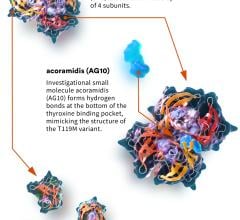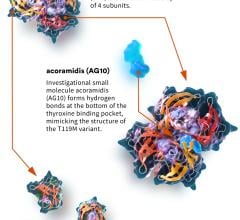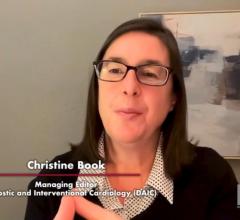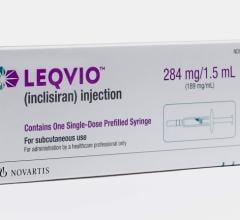January 14, 2014 — Daiichi Sankyo Company Ltd. announced results from the Phase 3 ENGAGE AF-TIMI 48
study [1]. The clinical trial found that the investigational, oral, once-daily direct factor Xa inhibitor edoxaban met the primary efficacy endpoint of non-inferiority compared to warfarin for the prevention of stroke or systemic embolic events (SEE) in patients with non-valvular
atrial fibrillation (NVAF). Once-daily edoxaban also demonstrated significant reductions in major bleeding compared to warfarin, achieving superiority for the principal safety endpoint. Results from ENGAGE AF-TIMI 48 were presented as a late-breaking clinical trial at the American Heart Association (AHA) Scientific Sessions 2013 in Dallas and published online in the
New England Journal of Medicine (
NEJM) [2].
ENGAGE AF-TIMI 48 compared two edoxaban treatment arms, 60 and 30 mg, with warfarin in 21,105 patients with NVAF for a median of 2.8 years. This represents the largest and longest trial with a novel anticoagulant in patients with AF performed to date. The edoxaban 60 mg treatment arm had an annual incidence of stroke or SEE of 1.18 versus 1.5% for warfarin (0.79 hazard ratio [HR]; 97.5% confidence interval [CI], 0.63 to 0.99; p < 0.001 for noninferiority) and significantly reduced major bleeding by 20% (2.75 vs. 3.43% per year, respectively) (0.8 HR; 95% CI, 0.71 to 0.91; p < 0.001 for superiority). The edoxaban 30 mg treatment arm had an annual incidence of stroke or SEE of 1.61 versus 1.5% for warfarin (1.07 HR; 97.5% CI, 0.87 to 1.31; p = 0.005 for noninferiority) and significantly reduced major bleeding by 53% (1.61 vs. 3.43% per year, respectively) (0.47 HR; 95% CI, 0.41 to 0.55; p < 0.001 for superiority) [2].
In ENGAGE AF-TIMI 48, patient-specific dosing was applied according to the study protocol. In both edoxaban treatment arms, the edoxaban dose was halved for patients with clinical factors that were known to increase the risk of bleeding (renal impairment, low body weight or concomitant use of certain P-glycoprotein inhibitors) [1, 2]. Patients receiving a reduced edoxaban dose in the 60 mg treatment arm had an annual incidence of stroke or SEE of 2.32 versus 2.68% for warfarin and a significantly reduced major bleeding incidence of 3.05 versus 4.85%. Patients receiving a reduced edoxaban dose in the 30 mg treatment arm had an annual incidence of stroke or SEE of 3.14 versus 2.68% for warfarin and a significantly reduced major bleeding incidence of 1.5 versus 4.85% [2].
"The results from the ENGAGE AF-TIMI 48 trial showed that edoxaban may provide a new treatment option for the prevention of stroke or systemic embolic events that demonstrates comparable efficacy to warfarin, while significantly reducing the risk of major bleeding. In addition, we identified an appropriate dose regimen for patients with clinical factors such as renal impairment and low body weight," said Robert Giugliano, M.D., S.M., FAHA, FACC, senior investigator, TIMI Study Group, physician cardiovascular medicine, Brigham and Women's Hospital, associate professor of medicine, Harvard Medical School, and co-global lead investigator, ENGAGE AF-TIMI 48 trial. "In conducting this landmark trial, we sought to provide clinicians with robust data, evident by the trial size and follow-up, high percentage of time in therapeutic range for the warfarin treatment arm and very low rate of missing data. In addition, we specifically designed a comprehensive transition plan to protect patients from the undue risk of stroke and bleeding when switching to open-label anticoagulation at the end of the trial."
"The edoxaban clinical trial program, the largest in the history of Daiichi Sankyo, has now yielded positive data for edoxaban in two major diseases, stroke prevention in atrial fibrillation and treatment of acute venous thromboembolism," said Glenn Gormley, M.D., Ph.D., global head of research and development and senior executive officer, Daiichi Sankyo, and executive chairman, Daiichi Sankyo Inc. in the United States. "Based on the findings from ENGAGE AF-TIMI 48 and Hokusai-VTE, we look forward to submitting New
Drug Applications for edoxaban in both indications by the first quarter of 2014 in the U.S., Japan and Europe."
Annual Incident Rates
Hemorrhagic stroke
- Warfarin: 0.47%
- Edoxaban 30 mg: 0.16% (HR, 0.33; 95% CI, 0.22 to 0.5; p < 0.001)
- Edoxaban 60 mg: 0.26% (HR, 0.54; 95% CI, 0.38 to 0.77; p < 0.001) [2]
Ischemic stroke
- Warfarin: 1.25%
- Edoxaban 30 mg: 1.77% (HR, 1.41; 95% CI, 1.19 to 1.67; p < 0.001)
- Edoxaban 60 mg: 1.25% (HR, 1; 95% CI, 0.83 to 1.19; p = 0.97) [2]
Intracranial hemorrhage
- Warfarin: 0.85%
- Edoxaban 30 mg: 0.26% (HR, 0.3; 95% CI, 0.21 to 0.43; p < 0.001)
- Edoxaban 60 mg: 0.39% (HR, 0.47; 95% CI, 0.34 to 0.63; p < 0.001) [2]
Fatal bleeding
- Warfarin: 0.38%
- Edoxaban 30 mg: 0.13% (HR, 0.35; 95% CI, 0.21 to 0.57; p < 0.001)
- Edoxaban 60 mg: 0.21% (HR, 0.55; 95% CI, 0.36 to 0.84; p = 0.006) [2]
Secondary composite endpoint of stroke, SEE and cardiovascular death
- Warfarin: 4.43%
- Edoxaban 30 mg: 4.23% (p = 0.32)
- Edoxaban 60 mg: 3.85% (p = 0.005) [2]
Cardiovascular mortality
- Warfarin: 3.17%
- Edoxaban 30 mg: 2.71% (p = 0.008)
- Edoxaban 60 mg: 2.74% (p = 0.013) [2]
The primary net clinical outcome (defined in the study protocol as the composite of death, stroke, SEE or major bleeding) was 8.11% per year for warfarin, 6.79% per year for the edoxaban 30 mg treatment arm (p < 0.001) and 7.26% per year for the edoxaban 60 mg treatment arm (p = 0.003) [2].
ENGAGE AF-TIMI 48 (effective anticoaGulation with gactor Xa next-generation in atrial fibrillation) was a randomized, double-blind, double-dummy, global Phase 3 clinical trial comparing once-daily edoxaban with warfarin at 1,393 centers in 46 countries [2].
Patients were randomized (1:1:1) to receive warfarin (n = 7,036), edoxaban 60 mg (n = 7,035) or edoxaban 30 mg (n = 7,034). Edoxaban dosage was reduced by half if any of the following was present at randomization or during the course of the study: creatinine clearance 30-50 mL/min, bodyweight < or = 60 kg or concomitant verapamil, quinidine or dronedarone (standard dosing was resumed if the concomitant drug was discontinued and no other dose reduction factors were present). The primary efficacy outcome was the time to first adjudicated stroke or SEE. The principal safety outcome was adjudicated major bleeding. Complete information on the primary endpoint was ascertained for 99.5% of the total 56,346 patient-years of potential follow-up with only one patient lost to follow-up. Warfarin therapy was proactively monitored throughout the trial, resulting in a median time within therapeutic range (TTR) of 68.4%. Adverse event (excluding bleeding) and discontinuation rates were similar among the three treatment groups [2].
ENGAGE AF-TIMI 48 implemented a pre-specified plan to transition patients to open-label anticoagulation at the end of the trial, which resulted in a low and evenly distributed number of events post-discontinuation of study therapy. In the 30 days following the transition, the number of patients experiencing stroke or SEE was the same in all three treatment groups (n = 7), while major bleeding occurred in 11 patients in the warfarin group compared to 10 and 18 patients in the edoxaban 60 mg and 30 mg treatment arms, respectively. These results demonstrate that the transition plan was effective in preventing undue risk of excessive stroke / SEE for edoxaban-treated subjects transitioning to a vitamin K antagonist (VKA) or a novel oral anticoagulant [2].
Edoxaban is an investigational, oral, once-daily anticoagulant that specifically and reversibly inhibits factor Xa [3]. The global edoxaban clinical trial program includes two Phase 3 clinical trials, Hokusai-VTE [4] and ENGAGE AF-TIMI 48 (Effective aNticoaGulation with Factor XA Next GEneration in Atrial Fibrillation) [1, 2], which are evaluating edoxaban, administered once-daily, for treatment and prevention of recurrence of venous thromboembolism (VTE) in patients with deep vein thrombosis (DVT) and/or pulmonary embolism (PE) and for the prevention of stroke and SEE in patients with NVAF, respectively [1, 2, 4].
Edoxaban is currently approved only in Japan, since April 2011, for the prevention of VTE after major orthopedic surgery, and was launched in July 2011 under the brand name Lixiana. Elsewhere, including Europe and the United States, edoxaban is currently in Phase 3 clinical development and has not been approved in any indication [5]. Results from the Hokusai-VTE clinical trial were presented at the European Society of Cardiology Congress Sept. 1, 2013 and published in NEJM [4, 5].
For more information: www.daiichisankyo.com, www.nejm.org
References
[1] Ruff, C et al. Evaluation of the novel factor Xa inhibitor edoxaban compared with warfarin in patients with atrial fibrillation: design and rationale for the Effective aNticoaGulation with factor xA next GEneration in Atrial Fibrillation-Thrombolysis In Myocardial Infarction study 48 (ENGAGE AF-TIMI 48). Am Heart J 2010; 160:635-41.
[2] Giugliano, RP et al. Edoxaban versus warfarin in patients with atrial fibrillation. N Engl J Med. 2013.
[3] Ogata, K et al. Clinical safety, tolerability, pharmacokinetics, and pharmacodynamics of the novel factor Xa inhibitor edoxaban in healthy volunteers. J Clin Pharmacol 2010; 50:743-753.
[4] Buller, H et al. Edoxaban versus warfarin for the treatment of symptomatic venous thromboembolism. N Engl J Med 2013; 369:1406-15.
[5] Daiichi Sankyo press release - Daiichi Sankyo launches LIXIANA (edoxaban), a direct oral factor Xa inhibitor, in Japan for the prevention of venous thromboembolism after major orthopaedic surgery. 19 July 2011. Available at: http://www.daiichisankyo.com/news/detail/004123.html. [Last accessed: October 2013].


 February 16, 2024
February 16, 2024 








